- Recent neck set, and leveling of original bar frets, action is very good
- Original Grover tuning machines, working well
- Nut width of 1 1/4"
- Scale length: 22.5"
- 1 3/8" string spacing at the saddle
- Had an added tailpiece at once point (3 tiny screw holes near end pin
- No top cracks
- One repaired 11" crack on the bottom lower bout side
- One 6" repaired crack on the upper bout back under the herring bone center inlay,
- One 4” repaired crack on the lower bout back towards the bottom
- A small hole at the center of the rear headstock– probably at some point for a nail to hang the instrument on a wall
- Neck has a comfortable V shape, leaning toward a U profile
-
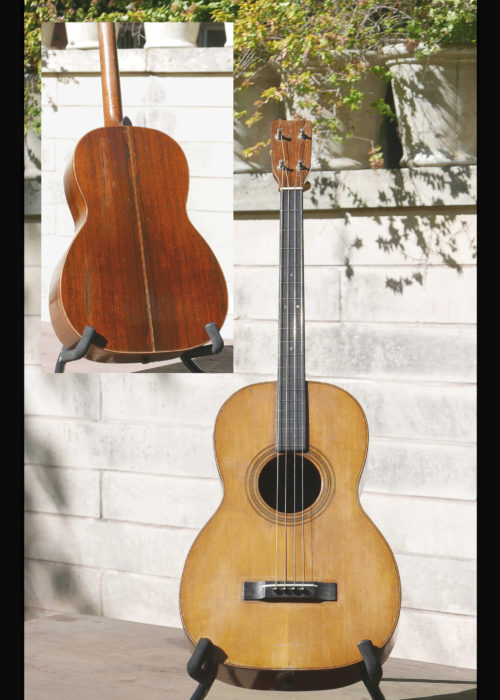 The 5-21 Martins, with their Brazilian Rosewood back and sides and Adirondack spruce tops, are known for putting out an astounding amount of sound. This tenor guitar, style 5-21T, does that in spades. Measuring 11-3/8" across, with its X braced top and light build, the instrument has an amazing amount of tone. Though Martin offered size 5 models ranging from style 15 through the elaborately ornamented style 45, the only ones made in any significant quantity prior to World War II were the style 17, 18, and 21 in six-string guitars and styles 17, 18, and 21 tenors, as well as some style 15 post-war size 5 tenors. Features of this instrument:
The 5-21 Martins, with their Brazilian Rosewood back and sides and Adirondack spruce tops, are known for putting out an astounding amount of sound. This tenor guitar, style 5-21T, does that in spades. Measuring 11-3/8" across, with its X braced top and light build, the instrument has an amazing amount of tone. Though Martin offered size 5 models ranging from style 15 through the elaborately ornamented style 45, the only ones made in any significant quantity prior to World War II were the style 17, 18, and 21 in six-string guitars and styles 17, 18, and 21 tenors, as well as some style 15 post-war size 5 tenors. Features of this instrument: -
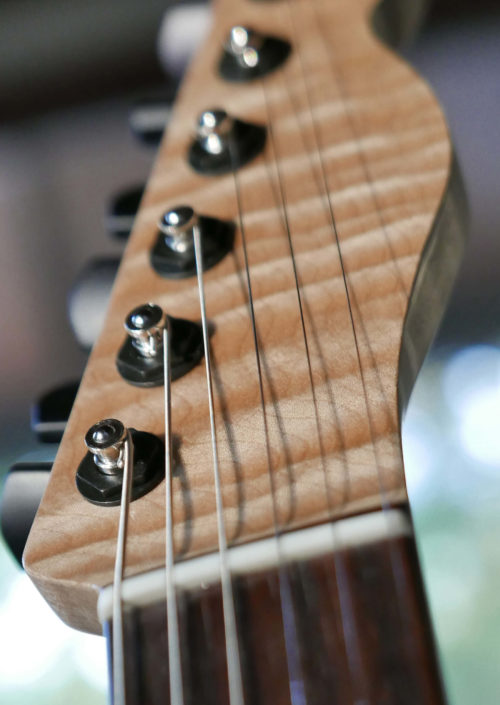 Another original, new, beautiful Custom Tele from master luthier Tony Nobles, based in Wimberly Texas. (Tony has crafted custom guitars for artists ranging in style from Joe Walsh to Alejandro Escovedo.) This guitar was custom made to our specs. And it’s one of one– the only one made with these features. Body: Figured Walnut top over adler Custom high end Musikraft quilted maple neck Width at the Nut: 1-11/16" Width at the Heel: 2-3/16 (55.56mm) Number of Frets: 21 Fret Type: Medium 6105 Finger Board Radius: 10" Body: natural, nitro lacquer finish Back of neck: natural, no finish Front of headstock: natural, nitro lacquer finish Bridge: Hannes by Schaller Non-Tremolo Bridge, #GTH RU-BLACK RUTHENIUM Tuners: Sperzel Trimlok Locking Guitar Tuners 6-in-line Trim-Lok Black Pickups: Harmonic Design "Vintage Plus" bridge and neck pickups
Another original, new, beautiful Custom Tele from master luthier Tony Nobles, based in Wimberly Texas. (Tony has crafted custom guitars for artists ranging in style from Joe Walsh to Alejandro Escovedo.) This guitar was custom made to our specs. And it’s one of one– the only one made with these features. Body: Figured Walnut top over adler Custom high end Musikraft quilted maple neck Width at the Nut: 1-11/16" Width at the Heel: 2-3/16 (55.56mm) Number of Frets: 21 Fret Type: Medium 6105 Finger Board Radius: 10" Body: natural, nitro lacquer finish Back of neck: natural, no finish Front of headstock: natural, nitro lacquer finish Bridge: Hannes by Schaller Non-Tremolo Bridge, #GTH RU-BLACK RUTHENIUM Tuners: Sperzel Trimlok Locking Guitar Tuners 6-in-line Trim-Lok Black Pickups: Harmonic Design "Vintage Plus" bridge and neck pickups -
Out of stock
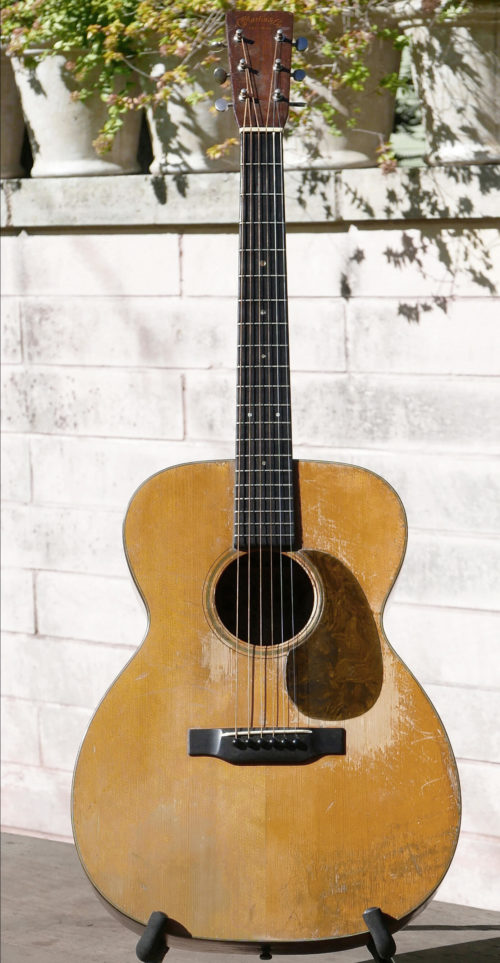 Impossible to mistake this guitar for a “1937 Authentic” or some such “recreation”. This 000-18 left the Martin factory in Nazareth, in 1937, indeed. And it’s been well-played since. More importantly, the tone is stellar– all you would expect from this style, this year, and more. Its bass response is similar to the best prewar D-18s. And it has the unmistakable string separation that only prewar Martins have. This instrument was in the family of its original owner until we obtained it. The original owner was Leroy Jenkins, a blind country artist in the 1950’s, in Texas, on the Dude label.
Impossible to mistake this guitar for a “1937 Authentic” or some such “recreation”. This 000-18 left the Martin factory in Nazareth, in 1937, indeed. And it’s been well-played since. More importantly, the tone is stellar– all you would expect from this style, this year, and more. Its bass response is similar to the best prewar D-18s. And it has the unmistakable string separation that only prewar Martins have. This instrument was in the family of its original owner until we obtained it. The original owner was Leroy Jenkins, a blind country artist in the 1950’s, in Texas, on the Dude label. -
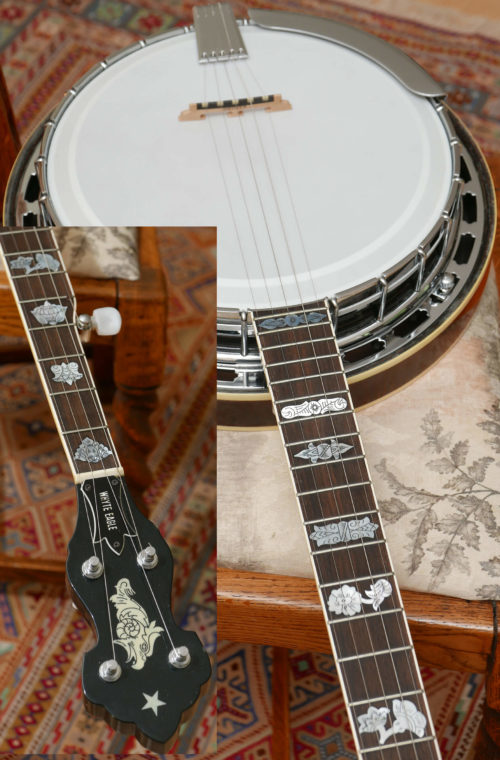 Early 1970s, but in remarkably original condition. And this instrument is from the first, early production– so it has the maple 3-ply rim. This should not be compared to later production Whyte Eagles– this is a very rare early one with unique features, and great tone. This banjo design is based on: • neck/head/inlays: based on the high end Fairbanks Whyte Ladye of the early 20th century– one of the most beautiful designs in banjo history • the pot assembly is modeled closely on the Gibson TB3, archtop of the 1930's. In fact it's a remarkable recreation of that design (and sound) – a more faithful recreation that many Gibson post-war versions. Bluegrass banjo players seek out the 70’s Alvarez Whyte Eagles, known for their tone and craftsmanship. It was a pretty short window of only about five years, when these banjos were made with this kind of craftsmanship. They blow away most any banjo made and marketed (from any country) in the 60s, 70s and 80s– and they show no logos on headstock– just beautiful mother of pearl. It’s the No. 4310 “Whyte Eagle”. Based on late 1920’s Vega Griffin (Tubaphone #9) style inlays, with engraved, carved heel. Sunburst finish maple banjo, Gibson-style 2 piece flange, full height 20 hole archtop tone ring, dual coordinator rods, flamed maple resonator, maple neck, chrome finish. Neck is butterfly with ebony strip on back of neck, down the center. It’s extremely rare to find a Whyte Eagle from this very early period (serial number 1672), when they first came out and the company bent over backwards to produce an instrument with zero compromise, from the inlays to the maple rim. The early features that are not on the later 70's Whyte Eagles, are– in addition to the 3-ply maple rim (not the 10-ply rim of almost all other Whyte Eagles)– the smaller star on the front of headstock (later models had a larger star), no “Alvarez” logo just the eagle inlay, and a darker sunburst on the resonator and also on the back of the neck. Flamed maple resonator (sunburst back, with a touch of milkiness to the original finish) Maple butterfly neck Hand-carved heel Mother of pearl inlays Original tuners Grover bridge 1 3/16 nut Scale: 26 ¼ inches 20 hole archtop tone ring 11 inch head ... no longer available ...
Early 1970s, but in remarkably original condition. And this instrument is from the first, early production– so it has the maple 3-ply rim. This should not be compared to later production Whyte Eagles– this is a very rare early one with unique features, and great tone. This banjo design is based on: • neck/head/inlays: based on the high end Fairbanks Whyte Ladye of the early 20th century– one of the most beautiful designs in banjo history • the pot assembly is modeled closely on the Gibson TB3, archtop of the 1930's. In fact it's a remarkable recreation of that design (and sound) – a more faithful recreation that many Gibson post-war versions. Bluegrass banjo players seek out the 70’s Alvarez Whyte Eagles, known for their tone and craftsmanship. It was a pretty short window of only about five years, when these banjos were made with this kind of craftsmanship. They blow away most any banjo made and marketed (from any country) in the 60s, 70s and 80s– and they show no logos on headstock– just beautiful mother of pearl. It’s the No. 4310 “Whyte Eagle”. Based on late 1920’s Vega Griffin (Tubaphone #9) style inlays, with engraved, carved heel. Sunburst finish maple banjo, Gibson-style 2 piece flange, full height 20 hole archtop tone ring, dual coordinator rods, flamed maple resonator, maple neck, chrome finish. Neck is butterfly with ebony strip on back of neck, down the center. It’s extremely rare to find a Whyte Eagle from this very early period (serial number 1672), when they first came out and the company bent over backwards to produce an instrument with zero compromise, from the inlays to the maple rim. The early features that are not on the later 70's Whyte Eagles, are– in addition to the 3-ply maple rim (not the 10-ply rim of almost all other Whyte Eagles)– the smaller star on the front of headstock (later models had a larger star), no “Alvarez” logo just the eagle inlay, and a darker sunburst on the resonator and also on the back of the neck. Flamed maple resonator (sunburst back, with a touch of milkiness to the original finish) Maple butterfly neck Hand-carved heel Mother of pearl inlays Original tuners Grover bridge 1 3/16 nut Scale: 26 ¼ inches 20 hole archtop tone ring 11 inch head ... no longer available ... -
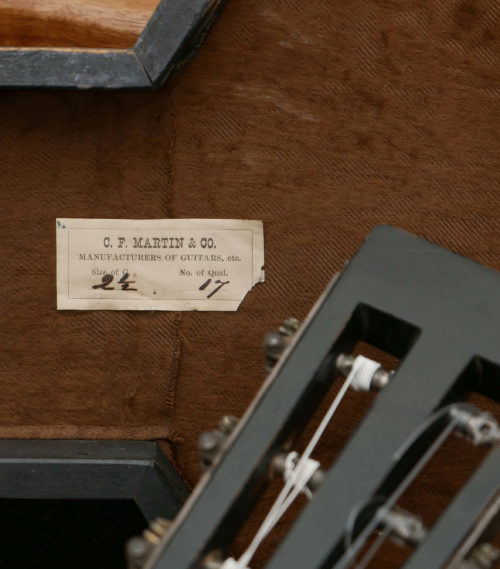 19th century Martin parlor guitar. This lovely sounding Martin 2 1/2-17 features solid Brazilian Rosewood back and sides, Adirondack spruce top, and original Jerome tuners. This particular instrument has a beautiful, lyrical voice. It was made probably circa 1867-1870. There are several clues to establish that: the original coffin case with the guitar has attributes of an earlier case: the small brass handle, and the label inside the case has font and other attributes of late a 1860s case. Also, the particular style of the original Jerome Tuners. Kerfing inside is also indicative of an 1860’s Martin. And, the best clue of all: the 1 ¾ inch nut width. Of course, it’s post-1867, because of the “CF Martin & Co” stamps inside. The top is fan braced, typical of this style. Measurements are: body length 17 7/8", lower bout width 11 5/8", overall length 36 1/2"; scale length 24 ½ inches. 4 inch body depth at end pin; 3 3/8 inch boy depth at neck joint. 1 ¾ inch nut width– may have been a custom order, or just a slightly narrower nut width (from the 1 7/8 more common later) from the factory. 12 fret cedar neck/ebonized, with ice cream cone heel. All original finish, everywhere. A fair-to-low amount of playwear (see photos). Original bar frets in fine condition. Several small hairline cracks in back, repaired. Top and sides also have a couple or repaired cracks. Reproduction ebony bridge– just made by Dick Dubois.. Original bar frets. Original bracing. "C.F. MARTIN &CO/ NEW YORK" hot stamped on back strip inside, and heel block. CF Martin New York stamped on back, by heel joint. Original Jerome tuners, with original buttons– note, one of the sun gears (on the G string tuner) has been replaced, with a different 19th century Martin sun gear (see photo). Historical interest aside (these just-post-civil war Martin guitars are more rare than the 1870’s/1880’s/1890’s examples), this guitar plays wonderfully. It projects glassy brazilian trebles, and clear mids and bass notes. It’s just a joy to play, and it just floats in your hands (due to its very light weight). Action is good, and it plays in tune even on the higher frets. (Note: 19th century Martins can be fitted with: gut strings, classical guitar strings, or sometimes silk and steel/tuned down–depending on the guitar. It’s really a case-by-case basis. One size does not fit all. And different 19th century Martins sound better with different strings. In this case, with this particular guitar, our favorite strings if you want a “classical” style string but more brightness and volume than nylon classical strings: Savarez Alliance composite High Tension strings (note, “high tension” by classical standards– fine for this instrument). This instruments sounds wonderful with those strings. In is original coffin case (and case has all the original hardware, as well as its original cloth interior lining).
19th century Martin parlor guitar. This lovely sounding Martin 2 1/2-17 features solid Brazilian Rosewood back and sides, Adirondack spruce top, and original Jerome tuners. This particular instrument has a beautiful, lyrical voice. It was made probably circa 1867-1870. There are several clues to establish that: the original coffin case with the guitar has attributes of an earlier case: the small brass handle, and the label inside the case has font and other attributes of late a 1860s case. Also, the particular style of the original Jerome Tuners. Kerfing inside is also indicative of an 1860’s Martin. And, the best clue of all: the 1 ¾ inch nut width. Of course, it’s post-1867, because of the “CF Martin & Co” stamps inside. The top is fan braced, typical of this style. Measurements are: body length 17 7/8", lower bout width 11 5/8", overall length 36 1/2"; scale length 24 ½ inches. 4 inch body depth at end pin; 3 3/8 inch boy depth at neck joint. 1 ¾ inch nut width– may have been a custom order, or just a slightly narrower nut width (from the 1 7/8 more common later) from the factory. 12 fret cedar neck/ebonized, with ice cream cone heel. All original finish, everywhere. A fair-to-low amount of playwear (see photos). Original bar frets in fine condition. Several small hairline cracks in back, repaired. Top and sides also have a couple or repaired cracks. Reproduction ebony bridge– just made by Dick Dubois.. Original bar frets. Original bracing. "C.F. MARTIN &CO/ NEW YORK" hot stamped on back strip inside, and heel block. CF Martin New York stamped on back, by heel joint. Original Jerome tuners, with original buttons– note, one of the sun gears (on the G string tuner) has been replaced, with a different 19th century Martin sun gear (see photo). Historical interest aside (these just-post-civil war Martin guitars are more rare than the 1870’s/1880’s/1890’s examples), this guitar plays wonderfully. It projects glassy brazilian trebles, and clear mids and bass notes. It’s just a joy to play, and it just floats in your hands (due to its very light weight). Action is good, and it plays in tune even on the higher frets. (Note: 19th century Martins can be fitted with: gut strings, classical guitar strings, or sometimes silk and steel/tuned down–depending on the guitar. It’s really a case-by-case basis. One size does not fit all. And different 19th century Martins sound better with different strings. In this case, with this particular guitar, our favorite strings if you want a “classical” style string but more brightness and volume than nylon classical strings: Savarez Alliance composite High Tension strings (note, “high tension” by classical standards– fine for this instrument). This instruments sounds wonderful with those strings. In is original coffin case (and case has all the original hardware, as well as its original cloth interior lining).